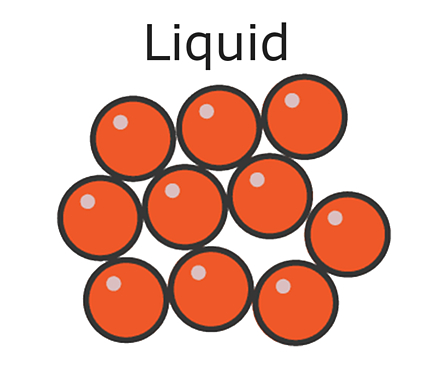how bonding and structure are related to the properties of substances
0.0(0)
Card Sorting
1/27
There's no tags or description
Looks like no tags are added yet.
Study Analytics
Name | Mastery | Learn | Test | Matching | Spaced |
|---|
No study sessions yet.
28 Terms
1
New cards
Name the three states of matter
The three states of matter are solid, liquid, and gas.
2
New cards

\
liquid
3
New cards

solid
4
New cards
gas
5
New cards
what changes of state take place at the melting point?
melting and freezing
6
New cards
what changes of state take place at the boiling point?
boiling and condensing
7
New cards
explain changes of state using particle theory (solid to liquid)
* when a solid is heated its particles gain more energy
* makes particles vibrate which weakens the forces holding the solid together
* at the melting point the particles have enough energy to break free so solid turns into liquid
* makes particles vibrate which weakens the forces holding the solid together
* at the melting point the particles have enough energy to break free so solid turns into liquid
8
New cards
explain changes of state using particle theory (liquid to gas)
* liquid is heated - particles gain more energy
* this energy makes the particles move faster wearing and breaking the bonds holding them together
* at the boiling point the particles have enough energy to break down their bonds
* this energy makes the particles move faster wearing and breaking the bonds holding them together
* at the boiling point the particles have enough energy to break down their bonds
9
New cards
explain changes of state using particle theory (gas to liquid)
* gas cools, particles don’t have enough energy to overcome the forces of attraction between them
* bonds form between particles
* at the boiling point bonds have formed between the gas so it becomes a liquid
* bonds form between particles
* at the boiling point bonds have formed between the gas so it becomes a liquid
10
New cards
explain changes of state using particle theory (liquid to solid)
* there’s not enough energy to overcome the attraction between the particles so more bonds form between them
* at the melting point, so many bonds have been held between them that they are in place - liquid becomes solid - freezing
* at the melting point, so many bonds have been held between them that they are in place - liquid becomes solid - freezing
11
New cards
describe factors that affect the melting and boiling point of a substance
* strength of forces between the particles of the substance
* nature of the particles depends on the type of bonding and the structure of a substance
* the stronger the forces between the particles the higher the melting point and boiling point of the substance
* nature of the particles depends on the type of bonding and the structure of a substance
* the stronger the forces between the particles the higher the melting point and boiling point of the substance
12
New cards
discuss the limitations of particle theory
* in the model there are no forces
* all particles are represented as spheres
* the spheres are solid
* all particles are represented as spheres
* the spheres are solid
13
New cards
recall what (s) (l) (g) and (aq) is in chemical equations
* solid
* liquid
* gas
* aqueous
* liquid
* gas
* aqueous
14
New cards
explain how the structure of ionic compounds affect their properties
* giant ionic lattice - strong electrostatic forces of attraction between oppositely charged ions in all directions in the lattice
* high melting points and boiling points because of the large amounts of energy needed to break down the strong bonds
* conduct electricity when melted or dissolved in water because the ions are free to move and charge can flow
* high melting points and boiling points because of the large amounts of energy needed to break down the strong bonds
* conduct electricity when melted or dissolved in water because the ions are free to move and charge can flow
15
New cards
structure of sodium chloride
* one giant ionic lattice
* Na+ and CL- Iona are held together in a regular lattice
* Na+ and CL- Iona are held together in a regular lattice
16
New cards
explain how the structure of small molecules affects their properties
* gases or liquids with low mp and bp
* weak intermolecular forces which increase with the size of the molecules
* atoms within molecules are held together by very strong covalent bonds
* not charged so don’t conduct electricity
* weak intermolecular forces which increase with the size of the molecules
* atoms within molecules are held together by very strong covalent bonds
* not charged so don’t conduct electricity
17
New cards
explain how the structure of polymers affects their properties
* large molecules
* atoms are linked to other atoms by strong covalent bonds
* Intermolecular forces between polymer molecules are strong
* solid at room temp
* atoms are linked to other atoms by strong covalent bonds
* Intermolecular forces between polymer molecules are strong
* solid at room temp
18
New cards
explain how the structure of giant covalent structures affects their properties
* solids with high mp
* atoms linked with strong covalent bonds
* bonds must be overcome to melt or boil substances
* diamond and graphite and silicon dioxide are examples
* atoms linked with strong covalent bonds
* bonds must be overcome to melt or boil substances
* diamond and graphite and silicon dioxide are examples
19
New cards
explain how the structure of metals and alloys affect their properties
* metals have giant structures of atoms with strong metallic bonding
* metals have high mp and bp
* solid at room temp
* malleable, can slide over each other
* pure metals - atoms arranged in layers - too soft for uses so are mixed with other metals to make them harder (alloys)
* metals have high mp and bp
* solid at room temp
* malleable, can slide over each other
* pure metals - atoms arranged in layers - too soft for uses so are mixed with other metals to make them harder (alloys)
20
New cards
why are metals good conductors of heat and electricity?
the delocalised electrons in the metal carry electrical charge through the metal
heat - because energy is transferred by delocalised electrons
heat - because energy is transferred by delocalised electrons
21
New cards
why are alloys harder than pure metals in terms of layers of atoms
when another element is mixed with a pure metal the new metal atoms will distort the layers of metal atoms making it harder to slide over each other making alloys harder than pure metals
22
New cards
properties of graphite
* each carbon atom forms three covalent bonds with three other carbon atoms forming hexagonal rings with no covalent bonds between the layers
* one electron from each carbon is delocalised
* high mp
* one electron from each carbon is delocalised
* high mp
23
New cards
properties of diamond
* paint covalent structure made up of carbon atoms that each form 4 covalent bonds making it very hard
* strong covalent bonds take lots of energy to break and give diamond a high mp
* doesn’t conduct electricity because it has no free electrons or ions
* strong covalent bonds take lots of energy to break and give diamond a high mp
* doesn’t conduct electricity because it has no free electrons or ions
24
New cards
properties of graphene
* one layer of graphire
* sheet of carbon atoms joined together in hexagons
* one atom thick
* strong network of covalent bonds
* contains delocalised electrons so can conduct electricity through the whole structure - used in electronics
* sheet of carbon atoms joined together in hexagons
* one atom thick
* strong network of covalent bonds
* contains delocalised electrons so can conduct electricity through the whole structure - used in electronics
25
New cards
structure of fullerenes
* molecules of carbon shaped in hollow balls
* carbon atoms arranged in hexagons
* carbon atoms arranged in hexagons
26
New cards
uses of fullerenes
* cage other molecules - can deliver drug into body
* huge surface area - help make great industrial catalysts
* can make great lubricants
* huge surface area - help make great industrial catalysts
* can make great lubricants
27
New cards
what tiny carbon cylinders can fullerene form?
* nanotubes
* ratio between length and diameter is high
* can conduct electricity and heat
* high tensile strength
* ratio between length and diameter is high
* can conduct electricity and heat
* high tensile strength
28
New cards
what was the first fullerene discovered?
buckminsterfullerene - c60 - spherical shape